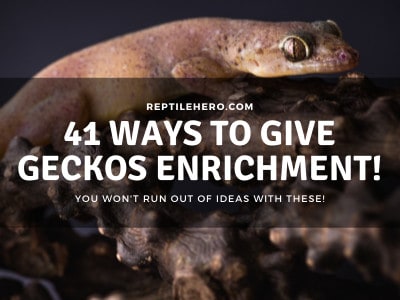Should You Bathe Your Leopard Gecko? (7 Times They Need It)
Bathing is a good thing for us, right? So it’s not surprising to see many new leopard geckos wanting to give their geckos a good soak. The problem, however, is they don’t really need it most of the time!
In general, leopard geckos do not need to be bathed and should not be bathed unless absolutely needed. For instance, a gecko may need a bath to disinfect an open wound or to keep a prolapsed organ moist. Even then, some experienced keepers recommend giving geckos saunas instead of baths as they are less stress-inducing.
You might have also heard of a couple of “special” baths geckos get from time to time like sugar baths. How is it exactly different and when is it needed? Find out as you read on!
Do Leopard Geckos Need to Take a Bath Regularly?
Leopard geckos do not need baths because they shed their skin whole or in big patches and don’t sweat. Hence, in normal circumstances, fit geckos, kept in an appropriate enclosure, and given vitamins and supplements along with a varied diet don’t need baths.
Unlike humans and many common pets, your leopard gecko will not shed tiny pieces of skin on a daily basis. It also won’t be able to sweat since it’s a cold-blooded or ectothermic animal. As such, they don’t even really get all that smelly.
Simply put, our cute little leos don’t really have a reason to bathe. Now, you might wonder, “what about all the dirt that could cling to their bodies?”

The thing is: dirt isn’t necessarily bad for geckos. It won’t harm them at all unless they ingest large amounts of it—which usually only happens due to bad husbandry. Besides that, they don’t need to clean substrate from their bodies.
Remember, in the wild, leopard geckos live in dirt-covered rocky grasslands. So it’s totally normal for some dirt to stick to their bodies from time to time. They don’t really get “dirty” from simply living on a soil-based substrate.
Also, loose substrate can actually be highly beneficial for geckos since it can provide enrichment through digging and thermoregulation. It helps with heat retention in the enclosure too!
Planning to give you leo an upgrade soon? Check our article on bioactive tank substrate!
When they do need to get rid of dirt and food that’s stuck to them, they can rub it off their bodies against rocks and wood. They could also just flick it from their toes or lick it off. In some cases, however, you may need to bathe your gecko.
A gecko with severe metabolic bone disease due to prolonged calcium and vitamin D3 deficiency, for instance, would often need a bath to help them shed—especially when their movement is very limited already. Keeping scrolling to learn when it’s okay to bathe a gecko!
Why do leopard geckos keep staying inside their tank’s water bowl?
A leopard gecko may stay inside its tank’s water bowl to cool down and not necessarily because it likes having a bath. So when excessive soaking in water is observed in a gecko, owners need to check the temperature and humidity levels inside the enclosure to ensure that a gecko is not sick, dehydrated, or overheating.
The 7 Cases When It’s Okay to Give a Leopard Gecko a Bath
A warm bath may help and give relief to a leopard gecko that is suffering from stuck shed, injuries, dehydration, mite infestation, constipation, retained plugs, and prolapse. Consultation with an exotic veterinarian is still needed for proper treatment.
Though baths can soothe a gecko that’s suffering, it is not a form of long-term treatment. Sure, you can give your gecko a bath to help it get more comfortable while waiting for your vet check-up. However, that can’t completely prevent or solve the underlying problem.
Nevertheless, it’s best to familiarize yourself with the only times a bath can be good for your gecko. In doing so, you can prevent several conditions from getting worse too quickly!
1. Stuck Shed
The most common reason why leopard geckos are given a warm bath is stuck shed. Before trying to remove retained patches of shed from a gecko, it’s important to soften it first.
You can do this by bathing your gecko for about 10–15 minutes [1]. After that, you can gently get rid of the softened old skin by using a cotton swab to roll it off.
Learn about the science behind this in our article on skin shedding in geckos.
Do not forcefully pull off shed, especially if it’s dry. You may inadvertently injure your gecko by peeling off its new skin as well.
2. Injuries
If you find your gecko with bloody body parts, visible open wounds, or a dropped tail, you will need to give it a warm povidone-iodine bath to prevent potential infections.
There is no specific recipe for this. Judge whether or not you’ve added enough povidone-iodine solution (here on Amazon) by the color of the bath water. Keep adding it until the water turn light brown—think of the color of iced tea.
Depending on the severity of the injury, you may give your gecko this special bath daily to help it heal. When the wound is only mild and shallow, you may not even need to bathe your gecko. Rather, you may simply have to flush it with the pure povidone-iodine solution.
However, it’s still best to get your local exotic vet to examine your gecko early on for the best treatment plan. Otherwise, if you bring your gecko only once its wounds have started to fester, it may be too late to treat the injury.
3. Mite Infestation
When your gecko is experiencing a mite infestation, you might not even need to force it into taking a bath.
Experienced keepers as well as veterinarians have observed that they willingly soak in shallow water to drown these pesky brown or red mites.
But to make a warm bath more effective for getting rid of mites, you could also add some povidone-iodine into the water. Then, make sure to no mites are left—especially in their armpit holes.
Still, I strongly advise you to visit your vet for a proper assessment to know whether or not they have also been infected by bacteria carried by mites.
4. Dehydration
Just like in the previous 2 cases, adding a special extra ingredient to a gecko’s regular bath water can do wonders for a gecko that’s feeling under the weather.
Sick geckos that are dehydrated can be rehydrated with an electrolyte bath at home before they can be brought to the animal hospital for proper treatment [2]. An electrolyte drink or powder like this one on Amazon can be really helpful in keeping them alive and well.
For rehydrating baths like this, mix equal parts of the electrolyte solution and water. Then, you can let your gecko soak for 10–30 minutes at a time to make sure it can drink and hydrate itself as much as possible.
But avoid citrus flavors like lemon, orange, or lemonade. They aren’t the best choice for geckos because they may contain a lot of citric acid which can upset their stomach.
5. Constipation
Another reason for bathing is constipation. A leopard gecko that hasn’t pooped for 1–2 weeks and hasn’t been showing much interest in any of the live feeder insects you offer—including its favorites—then it’s likely constipated.
This could happen when they are overfed, dehydrated, or stressed among other causes [3]. In other words, constipation or colonic impaction isn’t only caused by the ingestion of substrate due to pica or nutritional deficiencies.
Now, for such cases, a longer and warmer bath than normal may be beneficial—90–95°F or 32–35°C for up to 30 minutes twice a day. This is because heat is necessary for geckos to not only digest eaten food but also pass feces and urates.
Some people may also suggest you give your gecko soft massages but I personally advise against it as you might be putting unneeded pressure on their abdomens. It’s better to just go straight to your vet for appropriate treatment if they still haven’t pooped after 1 day.
6. Retained Plugs
Male leopard geckos who accumulate and retain massive sperm plugs can be in great discomfort unless these things can safely be removed by an exotic veterinarian.
However, you can help them feel more comfortable by giving them a warm bath. Having them soak in lukewarm water can help soften up the plug.
At times, just a single warm bath may even be enough for male leos to remove their plugs on their own.
In more serious cases, sperm plug can also result in prolapse if not treated promptly—which brings us to the last case.
7. Prolapse
Now, contrary to what some people say, it’s not only male leopard geckos that can suffer from a prolapse. Regardless of sex, leopard geckos can experience prolapse—of different internal body parts—due to a variety of reasons.
Aside from the hemipenes, the bladder, cloaca, colon, and oviducts of leopard geckos may also prolapse
In such instances, it’s important to keep the exposed internal organs moist. Otherwise, the tissue in these dry organs can rapidly start dying and may necessitate amputation or removal of that body part, which can be fatal.
Prevent prolapsed organs from drying and dying out by giving them a sugar bath. This is the third kind of special bath leopard geckos may be given. The addition of sugar to the water can help bring down swelling and allow for it to be placed back inside.
Other than dissolving granulated sugar, you can also use honey. Ideally, you want to mix this into the water while it’s still hot since stirring the water can make it cool down quickly.
What Do You Need to Give Your Gecko a Bath? (7 Cases)
Two main materials are needed to give a gecko a warm bath: 1) a shallow plastic container bigger than its body and 2) clean water not warmer than 95°F or 35°C. When necessary, a veterinarian may recommend adding povidone-iodine or sugar.
Don’t just plop your precious leopard gecko into your bathtub or sink if you have to bathe it. As a good rule of thumb, don’t bathe them where you handle and prepare your own food. It’s best to keep them away from your toothbrush as well!
You see, as much as I love geckos and many other reptiles, we can still catch salmonella—among many other things—from them if we aren’t careful enough. So it’s best to bathe leopard geckos in a contained space.

A regular plastic food container shallowly filled with clean water is all that’s necessary for a proper leopard gecko warm bath. Some also add a sheet or two of paper towels at the bottom so that their leos can have something to hold onto but this isn’t required.
Discover which types of water is safe for geckos!
Heat the water for the warm bath by either using an electric kettle or having it boil on the stove. Then allow it to cool down to the low 90s (about 32–34°C). Oftentimes, lukewarm water around 75–85°F (23–29°C) will be good enough for giving a gecko a warm bath [4].
In certain cases, your exotic veterinarian may recommend having the bath water a bit warmer, between 86–95°F or 30–35°C to lessen discomfort and pain from different conditions—including constipation and retained plugs.
You may also be instructed by your vet to add something else to the 1-inch deep warm water. Mixing in some povidone-iodine can prevent infections, whereas sugar helps with swelling.
Once you’re done bathing your gecko, don’t drain it in the kitchen sink or your bathroom sink. Throw away the used bath water into the toilet. That said, don’t forget to wash your hands before and after you handle your geckos to avoid the risk of spreading diseases.
What are the Problems of Bathing a Leopard Gecko? (4 Issues)
Leopard geckos don’t naturally bathe so the experience of being forced to soak in water can be highly stressful, which can be problematic. They can also drown in the bath. Moreover, constantly keeping wounded geckos in water can result in infections and hinder healing.
Keep in mind that tolerance to bathing can vary greatly from gecko to gecko, so it’s best to talk with your vet first to know if soaking it will help before and after their check-up.
If your gecko is still very new and not yet used to being handled, try placing its warm bath container in its enclosure. By doing so, they can voluntarily get in and out of the bath rather than be forced.
But remember, leopard geckos normally live in considerably dry regions and they rarely need to place themselves in large and deep bodies of water. So they can’t swim and may even drown if the level of the water in their warm bath is too deep.
When you do see them wiggling around in deep water, that isn’t swimming—that’s them struggling to get out to find dry land to stand on. So keep the water under their chins, more or less only 1-inch or 2.54-cm deep.
Seriously ill geckos that can’t raise or hold their heads up by themselves, like those with severe metabolic bone disorder, are in greater danger of drowning. Hence, sauna sessions may be better for them than baths.
Finally, wounds that are kept too wet from baths that are more frequent than necessary may result in bacterial or fungal infections [5]. It can also slow down the overall healing process.
Further Questions
How often should you give your leopard gecko a bath?
Leopard geckos rarely need to be given a bath as they normally groom themselves when needed. However, they may benefit from getting a 15-minute soak in preparation for shedding every 1–2 months or so. Other than that, a gecko may require a bath as often as twice a day if instructed by an exotic veterinarian to relieve conditions such as prolapse.
Is tap water safe for leopard geckos?
Depending on where you’re from, tap water may or may not be safe for a leopard gecko. It may need to be filtered thoroughly first before being used to bathe a gecko. Filtering the tap water will ensure that it can’t do more harm to a gecko such as infection from unclean water.
Can leopard geckos drink water through their vents?
Although some amphibians and reptiles are believed to be able to drink water through their vents during baths, this hasn’t been proven in geckos. In fact, scientists have shown that lizards such as leopard geckos don’t take up any water through their vents even when they are in water. However, they may lap at water to drink while soaking.
Summary of Should You Bathe Your Leopard Gecko
In contrast to humans, leopard geckos don’t require regular baths to keep themselves clean, especially since they don’t sweat and shed skin less frequently in big patches. Nonetheless, they can be given a bath when necessary using a simple plastic container and warm water at about 75–95°F or 23–35°C. Keep each session short, ideally under 30 minutes.
Leopard geckos should never be given baths for no reason. Only prepare warm baths for leopard geckos if they have shed issues, injuries, dehydration, mite infestation, constipation, retained plugs, or prolapse. However, it is ideal to still get them checked and treated by an exotic veterinarian.
Sources
[2] https://www.anapsid.org/signs2.html
[4] https://www.msdvetmanual.com/all-other-pets/reptiles/disorders-and-diseases-of-reptiles


![Can You Train Your Gecko? [5 Tricks It Can Learn Now]](https://www.reptilehero.com/wp-content/uploads/2021/02/Gecko-Training-Infographic-768x614.jpg)




